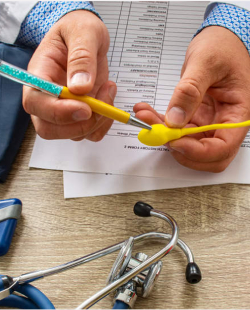Types of Abnormal Sperm
When we talk about infertility due to abnormal sperms, we always tend to assume that the issue lies in the number of sperms produced. But the fact is sperm morphology is also an essential factor when it comes to male fertility. A normal sperm has an oval-shaped head and a tail. There are multiple abnormalities of the sperm that can prevent it from fertilising an egg.
Types of Abnormal Sperm and Poor Semen Analysis Results
- Normozoospermia
Normozoospermia is the condition when all the sperms in the analysis were within the normal parameters. The normal parameters for semen analysis are as follows-- Semen volume- More than 1.5 ml
- Sperm concentration- 12- 16 million per ml
- Sperm count- 33-46 million
- Total motility- 38 to 42 %
- Progressive motility- 31- 34%
- Vitality- 55 to 63%
- Sperm morphology- 3 to 4 %
- Aspermia
In Aspermia, neither ejaculate nor sperm is produced. When a man has Aspermia, he may experience an orgasm called dry orgasm, but it may not produce an ejaculate. This can be a result of retrograde ejaculation, congenital abnormalities, genetic disorders like cystic fibrosis or Klinefelter syndrome, diabetes, sexual dysfunction and hormonal imbalance. While Aspermia can affect male fertility, the couple can have a biological child through IVF/ICSI treatment. - Hypothermia
Hypothermia is when the total amount of ejaculate produced is less than 1.5 ml. This can amount to less than a third of a teaspoon. Hypothermia and Aspermia can have similar causes, but it is commonly due to retrograde ejaculation. - Azoospermia
In Azoospermia, the ejaculate has absolutely no sperms and is said to have no sperm count. The semen can visually look completely normal, but when put through semen analysis, it shows the absence of sperm. Azoospermia can be caused due to reasons such as genetic disorders, congenital anomalies, sexually transmitted diseases and obstruction of the seminal tracts. It can also result from hormonal imbalances, infection like mumps, severe dysfunction and testicular cancer treatment. - Oligozoospermia
With Oligozoospermia, the semen does contain sperm but it is lower than normal amounts. Oligozoospermia can further be categorised as mild, moderate, severe and extreme. An extreme form of Oligozoospermia can also be called cryptozoospermia. This condition can also be accompanied by conditions like morphological problems and motility problems of the sperm. The condition can arise due to certain medications, celiac diseases, hormonal imbalances, genetic disorders, previous cancer treatment, varicoceles, reproductive tract infections, diabetes, and undescended testicles. It can also occur due to environmental conditions like overheating of testicles, exposure to toxic chemicals, use of drugs and alcohol, obesity, smoking. The condition can improve with lifestyle changes. While thiscondition can cause subfertility in men, they can go on to have babies without medical intervention. - Asthenozoospermia
Asthenozoospermia or sperms with abnormal sperm motility can occur by itself or together with low sperm count. Normal sperms must move progressively, in other words, the sperm must move in large circles or straight lines. Excessive alcohol use, illnesses, exposure to toxins, poor nutrition, medication, recreational drug use can all cause this condition. Sperm samples with less than 5 million sperms with normal motility is considered as severe male infertility. Over 20 million sperms with normal motility are considered normal. - Teratozoospermia
When the semen contains a large percentage of morphologically abnormal sperms, the condition is known as teratozoospermia. An abnormal sperm will have an odd head or have more than one head or tail. Teratozoospermia usually has a genetic cause. Globozoospermia is a type of teratozoospermia in which the sperm has a round head. These conditions can make it difficult for the sperm to move or fertilise the egg. - Oligoasthenoteratozoospermia (OAT)
When all the parameters like movement, sperm count and shape are abnormal, the condition is called Oligoasthenoteratozoospermia. It can further be classified as mild, moderate and severe. The treatment and the prognosis are heavily dependent on the severity of the condition. - Necrozoospermia
In Necrozospermia, the sperm in the sample are all dead. This condition is rare, and if it has sperms that are viable but are immotile. IVF and ICSI may help men with this condition to have a genetic baby. If the sperms are not viable, the fertility expert may attempt to remove immature and viable sperms through testicular biopsy to perform IVF or ICSI. - Leukocytospermia
When there are many white blood cells in the semen, the condition is called leukocytospermia or pyospermia. The white blood cells can cause damage to the
sperm, decreasing fertility. The high amount of white blood cells can also mean that the man is dealing with some infection. It can also be the result of an autoimmune disease.
Semen Analysis Results and Potential Fertility
One semen analysis showing infertility should not worry men. The normal ranges are set based on the percentiles or percentage of men who had the condition and had a child in a year’s time. Normal results on a semen analysis test do not guarantee fertility, nor does abnormal results guarantee infertility. Only consider the semen analysis as an investigative tool to diagnose the reason behind infertility, not a scale to measure fertility.
Further Male Fertility Testing
If you receive an abnormal result, your doctor may insist on performing another semen analysis. If there is trouble having the sample, you may be asked to have intercourse wearing a special sperm collection condom. Your doctor will then conclude after looking at the sperm analysis together with other tests.
What If Poor Results Repeat
If you still are presented with a poor result, your fertility expert will suggest treatments and lifestyle changes that can improve sperm health. Fertility treatments like IVF and ICSI will be recommended. The treatment will also be based on the partner’s fertility into account. Medications, surgery and lifestyle changes can take time to show the changes.



